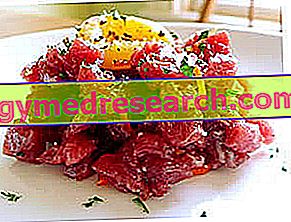What is the Laurel?
The laurel is an aromatic Mediterranean plant, perennial and evergreen, belonging to the Lauraaceae family, Genus Laurus, Species L. nobilis ; the binomial nomenclature of the laurel is Laurus nobilis .
NB .

Botanical description
The laurel is a tree that can reach 20 meters in height, but it is frequently adopted as a "hedge plant" and maintained in shrub form; the bark is gray-asparagus while the ovate-shaped leaves appear superficially bright and intense green (whereas they appear dull and pale green in the later). The laurel flowers are yellow, appear in spring and subsequently originate small drupes initially green and then black.
Laurel is a plant that prefers the temperate and typically Mediterranean climate; it grows spontaneously and luxuriantly in the coastal stretches of the basin (also in Italy, where it is considered a typical product of the Sicily region) and in Asia Minor. In cultivation, laurel bears well any type of soil and survives even in more continental climates, such as the Po valley.
Laurel in the Kitchen
As an aromatic plant, laurel is widely used both in the kitchen and in herbal medicine.
From the gastronomic point of view it is successfully associated (both in leaves and ripe drupes) with white, red, black (or game) meats and with offal (the " Fegatini alla marchigiana " are famous, wrapped in the retina of lamb with a leaf of laurel), as well as some varieties of water fish, both sweet and savory (excellent for the " Tinca alla bresciana " or for the " Sarde alla Fanese "). How to forget the " laurel liqueur ", prepared with 90 ° alcohol, water, granular sugar and fresh bay leaves.
The laurel can be used successfully in the formulation of aromatic salt, varying the intensity of the perfume and flavor based on the choice between early leaves (tender, pale green, delicate and light green) or mature (of dark green, thick, hard and particularly intense).
Flavored Video Salt (with or without laurel)
Flavored Salt for Vegetables, Meats and Fishes
X Problems with video playback? Reload from YouTube Go to Video Page Go to Video Recipes Section Watch the video on youtubeAll Bay Laurel Video Recipes
Nutritional Properties
Being an aromatic herb, the laurel is not used in quantities that modify the nutritional intake of the various preparations to which it is added (without considering that, in general, it is NOT eaten by the diner).
For information, the energy intake of laurel comes mainly from carbohydrates and lipids; also contains considerable amounts of dietary fiber and constitutes a veritable concentrate of mineral salts; among these we mainly distinguish: iron, calcium, potassium, magnesium, manganese, zinc and selenium.
From a vitamin point of view, laurel contains predominantly riboflavin, niacin and retinol equivalent (β-carotenes).
Laurel Herbalist
The laurel is not one of the aromatic ones of which it is possible to preserve the dried leaves since, following dehydration, these completely lose their organoleptic and gustatory characteristics (moreover, being an evergreen, the laurel plant supplies fresh leaves during the whole arc of the year). On the other hand, laurel is a natural preservative for cured meats; finely chopped together with: rosemary, pepper, red pepper, fennel and other spices, it promotes food preservation by virtue of its antibiotic capacity.
In herbal medicine, laurel is used in digestive decoctions, antiseptics and against the symptoms of diseases affecting the airways. The pure laurel berry oil is still used externally to relieve bruises and muscle contractures or, more rarely, against ear infections; it is also among the herbal packs against rheumatism.
NB . The essential oil of laurel is used more and more rarely because of its narcoleptic and sedative properties (responsible molecule: methylugenol ).
Other Uses
All readers will know the famous "laurel wreaths", used in the ornamental and symbolic composition for some occasions such as, for example, the achievement of the university degree; from the most remote times, the laurel symbolizes glory and conquest. Furthermore, curiously, the laurel plant is said to be the only tree that is NEVER struck by lightning (obviously, it is a popular legend).
In association with or replacing camphor, laurel leaves can help to remove moths from clothing (it goes without saying that the aroma should be appreciated, as the clothes will smell for the least a long time).
Bibliography:
- Encyclopedia of essential oils - G. Lawless - New Techniques - pag. 59.



